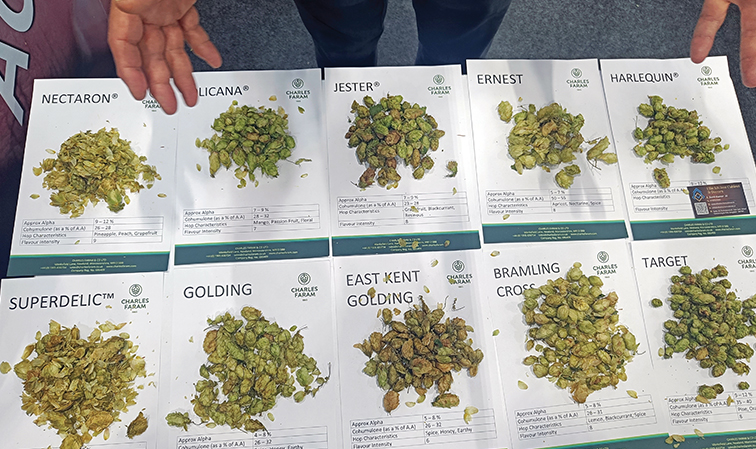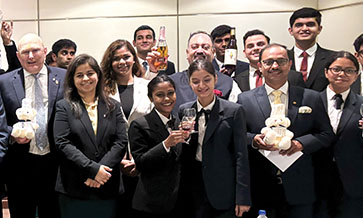UK-based Charles Faram is a leading producer, processor and distributor of high-quality hops worldwide. The company is owned by hop growers, ensuring a deep connection to hop cultivation and industry expertise. We caught up with Andrew Whalley, the company’s International Sales Manager, on the sidelines of the Brews&Spirits Expo in Bengaluru recently to understand this fascinating beer ingredient and how it reaches all corners of the world.
Could you introduce your company and yourself?
Founded in 1865, Charles Faram is a leading name in the hop industry. We manage the entire hop production process. It is working with growers in the UK through Charles Faram Farms and with other independent growers across all hop production areas worldwide. My role initially focused on UK customers, but since 2016, I’ve been expanding our international sales and nurturing relationships with distributors, including Brew Nation in India.
Is this something like a cooperative of farmers?
Yes, Charles Faram Farms is a cooperative owned by its grower members in the UK. We work with them very closely to encourage best practice and benchmarking to achieve top quality for the brewer. We manage acreage volumes by variety and encourage new planting when needed. We also work with growers across the globe to ensure consistent supply and quality of hops.
I didn’t realize the UK is a significant hop producer…
The UK’s hop production is relatively small compared to major producers like the US and Germany – they grow over 20,000 hectares of hops annually. The UK cultivates around 1,000 hectares.
Nevertheless, we have a rich hop-growing history, and our hops are renowned for their quality. Many hop varieties worldwide trace their origins to British hops from the early 1900s. Although UK hop acreage has decreased with changing consumer tastes, Charles Faram is trying to reverse that by pioneering development of new varieties with higher aroma and flavour through its hop development programme.
What climate is required for growing hops?
Hops thrive in regions between the 35th and 55th parallels, benefiting from long daylight hours in summer and cold winters. In the UK, this results in about 18 hours of daylight during peak summer.
Key hop-growing regions include Washington State in the US, Bavaria in Germany, the UK, New Zealand, Victoria in Australia, and parts of South Africa. Hops need cold winters for dormancy and warm summers, ideally not exceeding 35°C.
In India, hops have been cultivated in Kashmir, which has a suitable climate due to its latitude and seasonal temperature variations.
What challenges does Charles Faram face with climate change?
Climate change is a significant challenge, with longer, hotter, and drier summers affecting hop growth and quality. We are developing new hop varieties that can better withstand these conditions.
Increased regulations on chemical use and rising costs for fuel and crop protection are also factors we must manage. Our focus is on breeding resilient hops and reducing chemical reliance, aligning with industry trends toward more intense and aromatic hops.
Are there any hop varieties indigenous to the UK?
Yes, the UK has unique hop varieties, such as East Kent Goldings, which is geographically protected and can only be grown in East Kent. Some varieties, such as Goldings and Fuggles, are grown elsewhere.
Some new varieties developed by Charles Faram are exclusive to the UK. Moving plant material internationally is complex due to disease risks, so we keep certain varieties exclusive to the UK.
What is the hop growing season like?
The hop growing season in the UK is structured, with harvest occurring in September. Hops begin sprouting in March and can grow up to 5 metres tall by late summer. They climb strings set up by farmers, and excess shoots are trimmed to direct energy into producing fruit. This growth cycle from March to September is crucial for developing quality hops.
The hop breeding process involves planting around 10,000 seeds each year. After germination, we select and retain approximately 2,500 plants, discarding males and disease-prone ones.
We assess these plants for agronomic traits, hop cone quality, and flavour profile. Typically, only two or three new varieties are selected annually to ensure high standards.

Charles Faram is pioneering the development of new varieties with higher aroma and flavour through its hop development programme.
Why is genetic modification challenging for hops?
Genetic modification of hops is challenging due to their complex genetic makeup and large number of chromosomes. Instead, we use genetic markers to identify desirable traits. These markers help us select plants with specific compounds, such as geranium and linalool, crucial for flavour and aroma, streamlining the breeding process.
How are hops processed?
After harvesting, hops are mechanically picked and cleaned to remove cones from plants and debris. They are then dried to reduce moisture from about 90% to 10%, preventing spoilage. The dried hops are compressed into bales, pelletised at our facility, and packed in nitrogen-filled bags to prevent oxidation. We also create enriched pellets and extracts by concentrating essential oils from the hops.
Why are hops blended during beer production?
Blending hops is common in beer production. While we don’t blend hops at our facility, brewers often mix different varieties to achieve specific flavours and aromas. This blending helps create unique beer profiles and complements the malt and yeast, contributing to the beer’s overall character.
How long have you been supplying hops to India?
We have supplied hops to Indian brewers for about 14 years, with a more focused partnership with Brew Nation since 2017. The Indian beer market is vibrant and growing, contrasting with declining markets elsewhere. The enthusiasm for craft brewing in India is exciting and refreshing!
What trends do you see in the Indian beer market?
The Indian beer market is evolving with increased interest in styles, such as Belgian Wits and IPAs. Consumers are more accepting of diverse flavours and higher bitterness levels.
This shift towards more intense and flavourful beers is part of a broader trend seen globally. The growth of new breweries and rising craft beer interest make the Indian market dynamic and promising.
What makes New England IPAs suitable for the Indian market?
New England IPAs (NEIPAs) are suitable for the Indian market due to their low bitterness and vibrant, juicy flavours. They are smooth and fruity, offering an enjoyable experience without the intense bitterness of traditional IPAs. This profile aligns well with the Indian preference for flavourful yet approachable beers.
What about global beer trends and influences?
Global beer trends are shifting towards easy-drinking beers, such as lagers and pilsners, because consumers prefer less intense flavours. Highly bitter West Coast IPAs are declining in popularity. This trend reflects a broader move towards approachable and refreshing beer styles.
What has been your experience working with Brew Nation?
Working with Brew Nation has been highly positive. Since connecting with Ankit (Sethi) in 2017, his expertise and network in the Indian brewing industry have been invaluable. Brew Nation has helped us grow in the Indian market by leveraging Ankit’s experience and relationships with local brewers, leading to a successful partnership.
What is the competitive landscape like in the Indian hop market?
The Indian market for hops is competitive, with major players from the US and Germany are very active. Despite this competition, we focus on niche markets and personalised service, differentiating ourselves with unique offerings.
Are there any challenges in other markets you’re seeing?
Yes, developed markets such as Scandinavia and the US face challenges. In Scandinavia, declining beer consumption among younger consumers and a shift towards non-alcoholic beverages are affecting the market. In the US, competition from alternatives like cannabis impacts beer consumption. These trends require strategic adjustments to stay competitive.
Which emerging markets are showing the most promise?
South-East Asia and South Africa are promising. Thailand is experiencing growth in craft beer, while Vietnam faces challenges with new taxation laws. South Africa is seeing increased craft beer interest despite economic and infrastructural challenges. These regions offer opportunities as their brewing industries and consumer bases expand.
What is the outlook for the Indian craft beer market?
With a large population and growing interest in diverse beer styles, there is substantial potential for craft beer. While there are uncertainties, such as market saturation and regional differences, the influx of investment and innovation suggests a vibrant and expanding market for craft brewing in India.
Are there any other notable developments or insights you’d like to share?
The craft beer industry is evolving rapidly, and staying ahead requires adaptability and innovation. The rise of micro-breweries and unique beer styles, especially in emerging markets like India, highlights the dynamic nature of the industry. Embracing new trends and understanding market shifts will be crucial for navigating the challenges and opportunities in the global beer market.














